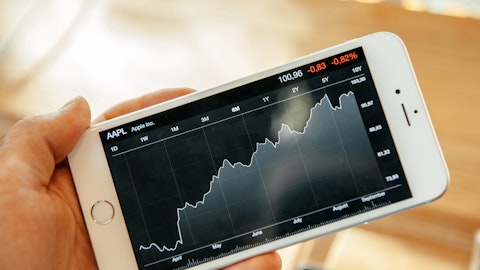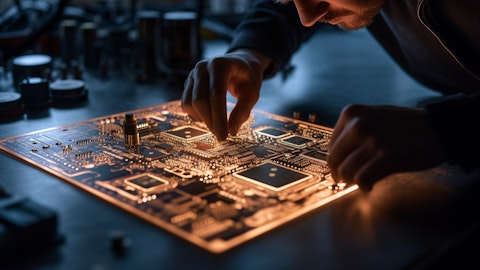Moving to the next slide. Despite the revenue headwinds in the near term, we are confident that we will Jabil to be more resilient as we’ve diversified across geographies, products, customers and end markets. Because of this, we’re not anticipating the same level of margin erosion traditionally seen in past slowdowns. Our diversified approach, global footprint and strong relationships with customers give us confidence in weathering these near-term challenges. We’re adapting, staying focused on margins and cash flow and committed to delivering value. Notably, by FY ’24, we expect core operating margins to come in higher than we expected in December at 5.6%. Three reasons largely account for our ability to drive margins higher despite lower revenue.
First, as our agile model allows, we pushed our planned investments and costs that will plan to support new ramps in renewables in the back half of the fiscal year, because of this, deleveraging is limited. Second, we expect to offset lower revenue with fixed cost recoveries from 5G and renewable energy customers. And third, we made progress with our efforts to align our cost structure and footprint with our go-forward business. All of this gives me confidence in our ability to deliver core operating margins of 5.6% in FY ’24 and positions us well for future margin expansion as we drive revenue growth higher on an optimized cost structure. Putting it all together for FY ’24 on the next slide. We expect our improved mix of business and optimization efforts will drive incremental operating leverage, thereby giving us the confidence to raise our core operating margin guidance to 5.6%, for FY ’24 on revenue of $28.5 billion.
We expect this dynamic to result in core EPS of $8.40, which is reflected by improved core operating income margin and accelerated share repurchases. Importantly, for the year, we also remain committed to generating more than $1 billion in free cash flow. Moving to the next slide. Overall, we feel good about the trajectory of our end market portfolio and are well positioned to drive growth in FY ’25 and headlined by continued growth in automotive, health care and AI data centers along with anticipated recoveries in areas of our business that are contracted this year. Globally, both EV and hybrid platforms continue to outpace ICE unit growth rates, albeit at a lower rate than we had originally anticipated at the beginning of the fiscal year.
Our EV business is supporting a number of new vehicle platforms with multiple customers in areas such as next-gen compute and control modules, power conversion battery management, LIDAR and other sensors as well as charging solutions. Additionally, we were recently awarded new business in optical camera modules where OEMs are redeploying optics hardware capabilities, enabling the rollout of different levels of autonomous driving through software updates. It is important to note the majority of the year-on-year growth we expect in EDs in FY ’25 will be driven by new programs and will be less reliant on volume growth with existing customers. These new platforms gives us confidence in our expectations of another year of growth for EVs in FY ’25.
Longer term, Jabil is well positioned to support both EV and hybrid technologies as they continue to take a larger overall share of auto unit growth globally. Within our health care business, we see significant opportunity to offer critical solutions and capabilities to customers outsourcing complex tasks. Jabil’s credibility in health care as the largest EMS provider in the space positions us well to take advantage of the growing outsourcing of manufacturing trend. In FY ’25, we anticipate another year of growth in our base business as we continue to explore opportunities in new capabilities and B2B transactions similar to our strategic collaboration from a few years ago. And in the data center space, there is a common theme forming among a number of our end markets related to the surge of investments in AI and ML.
The pace of AI investments continues to accelerate, and Jabil is winning our fair share of this growing pie as we have positioned ourselves well to assist our customers build out next-generation AI data centers. Our teams are quickly diversifying and winning share across multiple end markets in the AI data center infrastructure space, where we’re seeing growth in AI GPU right configurations accelerated optical switches for AI back end networking applications, silicon photonics, liquid cooling capabilities and power and energy storage. Given our success to date in this space, we now expect AI related net revenue across multiple end markets to be approximately $6 billion in FY ’25, or an increase of 20% year-on-year. Within the semi-cap market, we continue to anticipate demand to remain muted for FY ’24.
However, overall market dynamics are expected to improve as commentary across the industry suggests recovery may be on the horizon with a growing expectation that things improve towards the end of this calendar year, as fab utilization ticks higher and memory inventory normalizes. And in renewables, as we look to FY ’25, while we expect this end market to recover very slowly, we are winning new business and market share along with the aforementioned consolidation within our current customer base. Longer-term, we remain well-positioned to support secular growth in the renewable energy infrastructure space due to Jabil’s unique combination of power engineering expertise, in-region manufacturing and supply chain capabilities. Looking forward, we’re excited about the underlying momentum across our diversified portfolio and are well-positioned to drive growth in FY ’25.
Next, I’d like to provide an update on our share repurchases. In December, I outlined our intentions of executing a series of accelerated buybacks for the balance of the $2.5 billion repurchase authorization in FY ’24. I’m happy to say that we’re ahead of schedule with $825 million repurchased in Q2. This brings our year-to-date repurchase amount to 10.4 million shares for $1.3 billion for an average purchase price just under $127 per share. We fully anticipate completing the remaining $1.2 billion on our current repurchase authorization in FY ’24 and we’ll continue to opportunistically optimize our repurchases. With the plan in place and progress to date, I expect WASO to be in the range of $123 million to $126 million for FY ’24 and approximately $110 million to $113 million in FY ’25.





